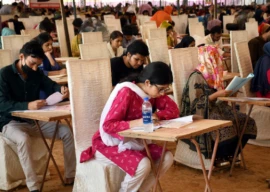
That has led to plans by the Sindh provincial government to invest Rs5.4 billion in installing 750 solar-powered reverse osmosis water purification plants across the sprawling desert district, to help get safe drinking water to the region’s over 1.5 million people.
All of the facilities are expected to be set up and working by June this year, the government said.
Residents living near a first plant, inaugurated in January in the Misri Shah area of Mithi, the district headquarters of Tharparkar, say it is transforming life in the parched region, where vanishing rain and drying groundwater supplies mean most available water is now saline or too high in fluoride.
'Hardly less than a miracle’
"It is really hardly less than a miracle for us that we can now drink sweet and clean water, for the first time in my entire life,” said 45-year-old Rekha Meghwar of Mithi, as she turns on the water plant’s tap to fill her pitcher.
Billed as the ‘Asia’s largest (by capacity) solar-powered water purification plant’, the facility will treat 3 million gallons of water daily, enough to meet the water needs of 300,000 people in Mithi and in 80 adjoining villages, according to officials in the Mithi town municipal office.
Constructed at a cost of Rs400 million, the plant is expected to particularly benefit women, who currently often must fetch water from far-away hand-dug wells.
Sunita Bheel, a woman waiting in line for water from the new Mithi plant, said women in the area often walk two kilometers a day to fetch water from a hand-dug well owned by a landlord outside the village.
Effect on migration
Local people said having water available for themselves, and their livestock, may stem increasing waves of migration from the area.
Anil Kumar, who lives in Morrey-Jee-Waand village, a few miles from Mithi, said 80 per cent of people in his village and in seven other villages around it migrated last September to other areas in the region with supplies of dam water in an effort to find potable water for themselves and their livestock, and to seek jobs after crops failed.
"But they are now gradually returning to their villages when they learn about the sweet water (plant),” said the 65-year-old guar farmer, who looks after the property and belongings of neighbors who have migrated.
Today, Kumar rides every other day on his mule, strapped with two empty 30-liter drums, to the filtration plant to bring back water, he said.
Access to useable water is a key problem in drought-hit Tharparkar. Barely 5 per cent of the population has access to clean and disease-free potable water, according to a study by Dow University of Health Sciences (DUHS) and the Pakistan Council for Scientific and Industrial Research (PCSIR).
One reason for this has been worsening fluoride contamination of underground water sources as less water recharges the drying system. The study found that the fluoride level at many locations in Tharparkar is at dangerous levels of over 13 mg/liter compared to the 1 mg/liter considered normal.
Excessive fluoride intake, from sources with more than 1.5 mg/liter of fluoride in the water, can cause problems such as bone deformation, dental problems, and damage to the kidneys and thyroid.
No rain, no rivers
Tharparkar depends heavily on rain-fed ground water, as it has no rivers. It receives an average annual rainfall between 200 and 300 millimeters, 80 per cent of it during summer monsoon season, which runs from July to September. The rainfall recharges groundwater that must then last for the other three quarters of the year.
Since 2011, however, average annual rainfall each year has been less than 50 per cent of normal, straining further already depleting groundwater resources, according to the Pakistan Meteorological Department.
“Given the current grim state of water woes, establishment of water purification plants is a welcome move,” said Abdul Hafeez, the country manager at WaterAid – UK, a global water charity.
But water shortages in the area could be solved even more effectively by tripling the amount of rainwater harvesting going on in the district, he said.
COMMENTS (2)
Comments are moderated and generally will be posted if they are on-topic and not abusive.
For more information, please see our Comments FAQ

1726117332-0/Megan-Thee-Stallion-(1)1726117332-0-165x106.webp)





















RO plant is failure project of sindh govt,only loot maar from funds,in this amount sindh govt send baargae water in Thar but its only some days soulation for thari peoples and then chemical water spread diseases in thari people
Why the govt of PPP took this long to install the solar power system for water ? what were they doing for the last 5 years when in center & province...oh ! they were busy looting & plunder, making for the loss for the past absence from govt....they knew that this will be their last chance to be in power both in center & province. They knew they came to power on sympathy vote & hence, make hay while the sun shine.